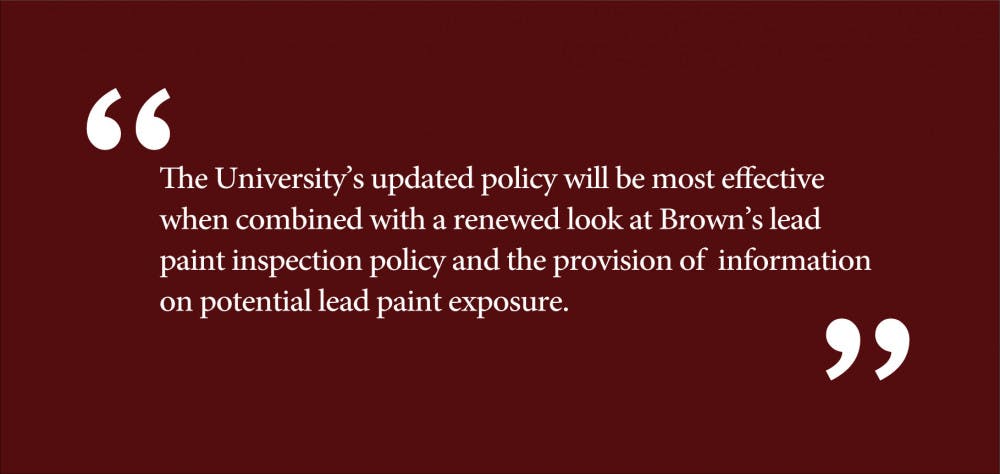In mid-November, The Herald reported the troubling news that residents in Donovan House, where one of the University’s special interest housing programs is located, discovered what they believed to be lead paint in areas of the dorm with chipped paint. Officials from Environmental Health and Safety inspected the residence and determined that, though the paint damage did perhaps reveal lead paint, it was unlikely to cause lead exposure. The University decided that the damaged areas would nonetheless be repainted over winter break. It is good to see the University respond rapidly to student concerns about lead paint found in campus residences. Nevertheless, it has become evident that the University needs to improve its policies regarding how it checks for lead paint, inform students about the status of lead paint in dormitories and communicate the procedures students should follow to avoid lead exposure.
To be sure, even the slight chance of lead paint exposure is a serious problem. Though the University reported that the degree of paint damage found in Donovan House is not significant enough to constitute lead exposure, whenever paint becomes damaged in a building that predates 1978 — when federal law outlawed the use of lead paint — there is the potential for chipped coats of paint to expose old layers of lead paint. When this happens, it becomes possible for residents to inhale airborne lead paint particles. Since many of Brown’s residence halls were built before 1978, this is a possibility that all students should be made aware of. Lead poisoning can cause damage to the brain and other vital organs and can lead to headaches, stomach aches and exhaustion, among other more serious illnesses. As one University professor put it in a research report press release this fall, “there is no safe level of lead.”
Thus, it remains incredibly disconcerting that the critical task of ensuring campus residents are not subject to any level of lead exposure has essentially been left to residents themselves — with many largely unaware that this burden has fallen on them. Though the Office of Residential Life told The Herald that Facilities Management checks for exposed lead paint every May when students move out, this policy — as evidenced by the case of Donovan House — is in need of serious scrutiny.
While the University acknowledges that wear and tear could cause paint chipping that would contribute to lead paint exposure throughout the school year — during which there are no procedural checks for lead paint — the University does not currently make students aware of the extent of this potential problem or provide them with resources for reporting issues during their time in the residence halls. While we commend the University for planning to move forward with factsheets for students that would clarify these issues, it is troubling that this was not done sooner. Furthermore, future communication on this issue should provide students with better clarity regarding the reporting process for lead paint exposure and should include detailed information about how students can follow up on this issue.
Moreover, since a Donovan House resident reported noticing the exact same lead paint exposure last year, it remains questionable whether or not this policy of checking for lead paint exposure every May even works successfully. We encourage the University to look into this potential oversight and remain transparent with students as it continues to modify and improve its policies on lead paint in residence halls.
The University is not alone in its struggles with lead paint prevalence. In 2015, Yale students in one residence hall reported decaying paint that was determined to have 15 times the level of lead at which paint is considered dangerous. In the end, Yale decided to repaint dozens of dorm rooms to fix the problem, but it failed to inform the current inhabitants of what was ocurring. Brown can learn a lot from Yale’s handling of the situation: It is unacceptable to expose students to hazardous environmental conditions, to put the burden of lead monitoring on students themselves and to hide episodes of chipped paint or degraded infrastructure from students.
While state and federal laws mandate that sellers and landlords disclose any and all knowledge of the presence of lead-based paint in residences to homebuyers and renters, federal law exempts college dormitories from this practice. As such, we commend the University for being willing to include lead paint disclosures in housing contracts moving forward. These disclosures, however, are not enough. The University’s updated policy will be most effective when combined with a renewed look at Brown’s lead paint inspection policy and the provision of information on potential lead paint exposure. It is only with these improvements to Brown’s lead paint policy that we will be able to fully ensure that students do not live in fear and uncertainty about the health and safety of their living environments during their time at Brown.
Editorials are written by The Herald’s editorial page board: Anuj Krishnamurthy ’19, Rhaime Kim ’20, Grace Layer ’20, Mark Liang ’19 and Krista Stapleford ’21. Please send responses to this opinion to letters@browndailyherald.com and op-eds to opinions@browndailyherald.com.





